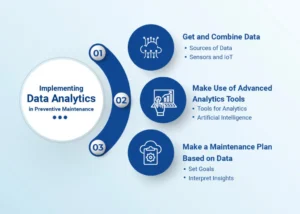The Role of Data Analytics in Preventive Maintenance Planning
2024-08-27
In this day and age, it is crucial to maintain and ensure the proper functioning of your assets. Many sectors, including manufacturing, aviation, and the oil and gas industry, have recognized the importance of maintenance management. The use of data analytics for maintenance management has completely altered how companies take care of their assets. Traditional maintenance methods have been changed by the addition of data analytics, which provides powerful tools for improving equipment reliability, lowering costs, and making maintenance activities more efficient. This blog delves into the critical role of data analytics in preventive maintenance planning, examining how it improves decision-making, increases operational efficiency, and contributes to overall success.
What is Data Analytics?
Data analytics is the study of raw data to find insights that can be used. A variety of tools, technologies, and methods are used to make this possible. These tools use this data to help find trends and solve problems. It can help businesses make better choices and be more productive overall.
Role of Data Analytics in Maintenance Management
Previously, technicians were responsible for collecting data. Once gathered, they used to forward the information to their managers or supervisors for further analysis. Then, superiors used the data to do analytics and decide what action needed to be taken.
Data analytics is now an important part of maintenance. As times have changed and technology has improved, so has the way data is gathered. Software now gathers and analyses data automatically, eliminating the need for manual data collection.
Implementing Data Analytics in Preventive Maintenance
Here are some steps that companies can take to effectively use data analytics in planning for preventive maintenance:

Get and Combine Data
- Sources of Data: Get information from a variety of places, such as sensors on equipment, maintenance logs, and operational systems.
- Putting this information in one place will make it easier to look at in more detail.
- Sensors and IoT: Use Internet of Things (IoT) devices and sensors to get information about the condition and performance of equipment in real time. For condition-based maintenance and predictive analytics to work correctly, this information is very important.
Make Use of Advanced Analytics Tools
- Tools for Analytics: Purchase high-tech software and platforms for analytics that can deal with big data sets and give you predictive insights. These tools perform complex analyses and give suggestions for what to do next.
- Artificial Intelligence: Use machine learning algorithms to look at old data and easily make a guess when equipment will break down in the future. Machine learning models are always getting better at making predictions as new data and trends come in.
Make a Maintenance Plan Based on Data
- Set Goals: Set clear goals for the preventive maintenance plan, like lowering downtime, making equipment last longer, or making better use of resources.
- Interpret Insights: Utilize data insights to create maintenance plans and schedules that can be put into action. Make sure that the maintenance tasks are in line with the condition of the equipment and its operational requirements.
One Software to Manage Your Different Preventive Maintenance Requirements
Data analytics is now an important part of planning for preventive maintenance because it gives us useful information and the ability to predict the future, which helps us improve the performance of equipment, make maintenance schedules more efficient, and better manage resources.
By using AntMyERP’s data analytics in preventive maintenance plans, businesses can switch from reactive to proactive maintenance, which saves them a lot of money and makes their operations run more smoothly. Organizations can get the most out of preventive maintenance and ensure long-term success by investing in AntMyERP’s advanced analytics tools.
AntMyERP is the best way for a business to handle its preventive maintenance requirements. Our software manages Time-Based, Usage-Based, and Dynamic Complex Preventive Maintenance. This ensures that equipment lasts as long as possible, functions properly, and requires as little downtime as possible. You can make a maintenance plan that fits your needs with AntMyERP, and it is all done on one intuitive platform. Choose AntMyERP for all of your preventive maintenance needs, and you will not have to worry about lost productivity or unexpected downtime.
AntMyERP also helps with services such as After-sales Service Management, AMC management, Warranty management, Return Material Authorization, etc.

